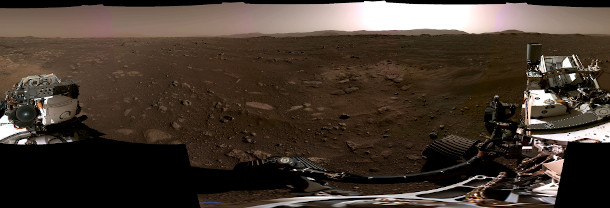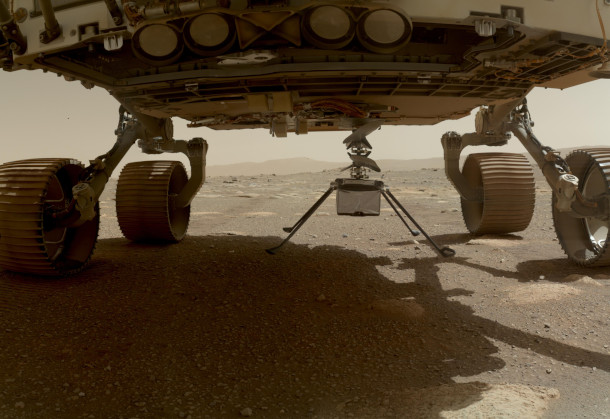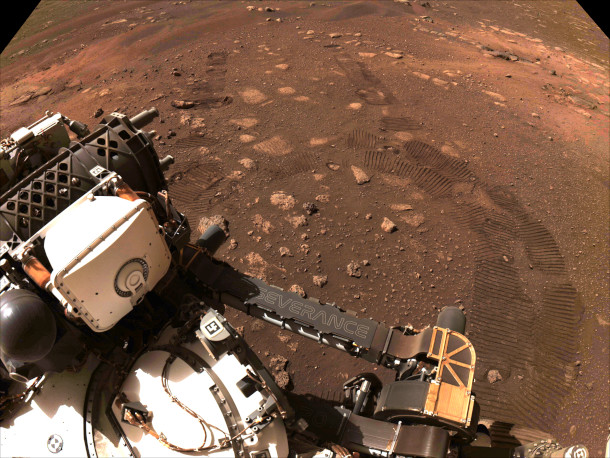The Sounds of Mars
Air Date: Week of July 8, 2022

A panoramic view of Perseverance’s landing site on February 18, 2021. (Photo: NASA, Public Domain)
The first successful Mars lander was Viking 1 in 1976, and now, after dozens of missions NASA has finally captured the first ever audio recorded on the surface of the red planet. Host Aynsley O'Neill shares these recordings with Host Bobby Bascomb and explains how Mars' atmosphere alters sound compared to how we experience it here on Earth.
Transcript
BASCOMB: Just ahead in the program we’re going to take a deep dive into deep space but first I want to bring in Living on Earth’s Aynsley O’Neil who has been listening to sounds of space a little closer to home.
Hey there, Aynsley!
O’NEIL: Hey Bobby
BASCOMB: So, what do you have for us?
Well, NASA spacecraft first landed on Mars with the Viking 1 in 1976. And finally, now after almost 50 years and dozens of missions, the Perseverance rover has recorded the first sounds ever captured on the surface of the red planet.
BASCOMB: Oh, wow, so what does Mars sound like?
O’NEILL: Well, I wasn’t sure what I should be expecting at first – my original impression of what Mars could sound like was based on Ridley Scott’s movie adaptation of The Martian.
[SFX: “THE MARTIAN” AUDIO]
[SFX: STORM]
LEWIS: Visibility is almost zero. Anyone gets lost, home in on my suit's telemetry. You ready?
WATNEY: Ready!
[SFX: STORM]
WATNEY: Commander? Are you okay?
LEWIS: I’m okay!
[SFX: STORM]
CURWOOD: So I’m gonna guess that’s not quite what NASA’s audio sounds like.
O’NEILL: No, not exactly. For one, there’s no sweeping movie score to accompany it. Actually, in the first raw audio captured from Mars, most of what you can hear is just the humming of the Perseverance rover. That’s where the microphone is mounted.
[SFX: FIRST SOUNDS FROM MARS – RAW AUDIO]
O’NEILL: But with a little audio filtering, NASA dialed back those rover sounds, and the wind from the planet comes through a little stronger.
[SFX: WIND ON MARS]
O’NEILL: There’s also the sound of the Perseverance rover rolling across the Jezero Crater just a few Martian weeks into its mission.
[SFX: ROVER DRIVING ON MARS – FILTERED]
O’NEILL: And for the first time, a spacecraft on another planet recorded the sounds of a separate spacecraft when Perseverance used one of its microphones to listen to the Ingenuity helicopter during its fourth flight on Mars.
[SFX: HELICOPTER FLYING ON MARS]
BASCOMB: Now, Mars has a different atmosphere than Earth, so that’s sure to alter how sound waves move, right?

In this photo, the Ingenuity helicopter is deployed from underneath the Perseverance rover. (Photo: NASA, public domain)
O’NEILL: Yeah, the atmosphere of Mars is roughly 96% carbon-dioxide, and those molecules absorb a lot of higher pitched sounds, so only low pitch sounds would be able to travel long distances on the red planet. So, the sounds of some city birds here on Earth
[SFX: EARTH BIRDS]
kind of get lost on Mars.
[SFX: MARS BIRDS]
O’NEILL: Also, because the atmosphere is around 100 times less dense than Earth, there are fewer atoms for the sound waves to vibrate through, so volume would be quite a bit softer than here on Earth. The sharp sound of a bike bell
[SFX: EARTH BIKE BELL]
gets muffled on the red planet.
[SFX: MARS BIKE BELL]
O’NEILL: To top it off, Mars’ average surface temperature hovers around negative 80 degrees Fahrenheit.
BASCOMB: Wow, that’s cold – what does that do to the sound?
O’NEILL: All these factors work together to make the Martian speed of sound a little slower than on Earth, where it moves at around 340 meters per second. And on Mars there are actually two speeds of sound: low-pitched noises travel at around 240 meters per second, while higher-pitched noises clock in at 250 meters per second. This is because the carbon dioxide molecules in the atmosphere vibrate too rapidly at the higher frequencies, and don’t have the time to slow down.
BASCOMB: So, any person on Mars would have to be in a space suit to breathe, of course, but let’s just imagine that two people were able to talk to each other – what would that sound like?
O’NEILL: Well, that would depend on the distance between the two people, but overall, sound would be quieter, and it would take those people a little bit longer to hear each other.
BASCOMB: So, on an alien planet, we would even sound a little alien.

The Perseverance rover is now moving up the slope of the Jezero crater, looking for new rock samples. (Photo: NASA, public domain)
O’NEILL: Yep, and NASA even has a tool that will allow you to filter your own Earth audio, so you can hear what it would sound like on Mars.
For example, let’s wrap up by listening to a familiar song. Maybe the Living on Earth theme tune?
BASCOMB: Sure, go for it!
[SFX: LOE THEME, MARS VERSION]
BASCOMB: And by the way the Perseverance Rover is now rolling up the slope of the Jezero crater. It will collect a group of rock samples that scientists are hoping might contain hints of ancient life on the planet’s surface.
Links
Find out more about the audio captured on Mars at NASA’s website
Living on Earth wants to hear from you!
Living on Earth
62 Calef Highway, Suite 212
Lee, NH 03861
Telephone: 617-287-4121
E-mail: comments@loe.org
Newsletter [Click here]
Donate to Living on Earth!
Living on Earth is an independent media program and relies entirely on contributions from listeners and institutions supporting public service. Please donate now to preserve an independent environmental voice.
NewsletterLiving on Earth offers a weekly delivery of the show's rundown to your mailbox. Sign up for our newsletter today!
 Sailors For The Sea: Be the change you want to sea.
Sailors For The Sea: Be the change you want to sea.
 The Grantham Foundation for the Protection of the Environment: Committed to protecting and improving the health of the global environment.
The Grantham Foundation for the Protection of the Environment: Committed to protecting and improving the health of the global environment.
 Contribute to Living on Earth and receive, as our gift to you, an archival print of one of Mark Seth Lender's extraordinary wildlife photographs. Follow the link to see Mark's current collection of photographs.
Contribute to Living on Earth and receive, as our gift to you, an archival print of one of Mark Seth Lender's extraordinary wildlife photographs. Follow the link to see Mark's current collection of photographs.
 Buy a signed copy of Mark Seth Lender's book Smeagull the Seagull & support Living on Earth
Buy a signed copy of Mark Seth Lender's book Smeagull the Seagull & support Living on Earth

